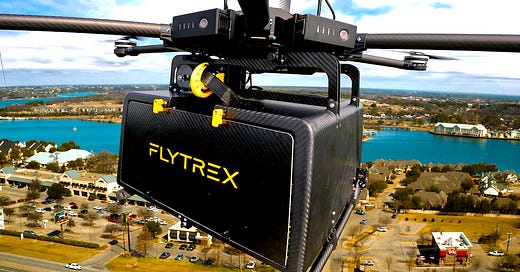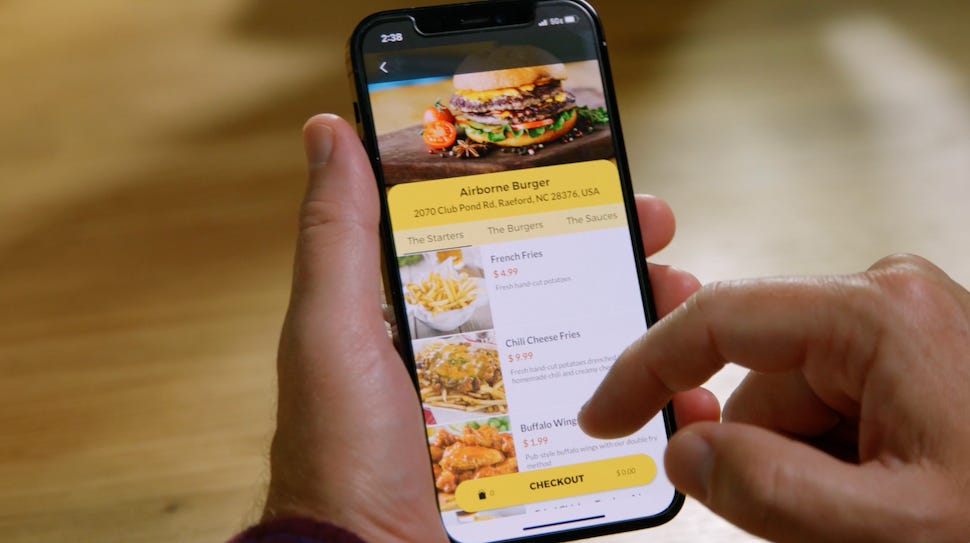Last week, Flytrex, an on-demand drone delivery startup for food and retail, announced the expansion of its drone delivery service in Texas. A few years ago, Flytrex began delivering food orders to front and backyards via drone in the neighborhoods of North Carolina, in partnership with Chili’s Grill & Bar, and is now expanding.
When using the service, customers order food on the Flytrex app (the same way they would order on DoorDash), Flytrex employees grab the food from the restaurant, clip the bag to a cable, load it into the drone delivery box, and launch the drone to its destination. The delivery box can handle up to 6.6 pounds, which is essentially a 4-person meal.
The app updates the customer regarding their order status along the route, and since customers can’t directly interact with the drone, they wait until the package is lowered by wire on to their front or backyards.
This is clearly very exciting and in stark contrast to one of the darkest weeks of on-demand ultra-fast delivery which was loaded with layoffs (GoPuff) and closures (Fridge No More and Buyk).
Drone delivery in and of itself is not new. Amazon has been working on its drone program since 2013 and has not expanded it until a recent announcement on testing new services in California and Texas. Zipline has been delivering vaccines in Africa using its drones, and now is working with Wal Mart to offer new services.
This is an excellent example of the Gartner Hype Cycle. During 2015-2016, drone delivery was all the rage. But soon thereafter, firms realized that the promise could not be “delivered,” only to see more and more firms considering it once again.
What has changed? Some of it has to do with the maturity of the technology, and some of it has to do with the maturity of the Federal Aviation Administration (FAA) regulations regarding drones and their operations.
Up until recently, Flytrex had to conduct all flights under Part 107.31 of the FAA, meaning that the operator of the drone had to be within a visual line of sight, in order to maintain the highest safety standards. As we can imagine, this was extremely restrictive. Since December 2021, the firm received authorization to fly its drones over people and moving vehicles within a 1-nautical-mile radius of its operating stations, while the operator tracks the drone via a monitor.
There are multiple questions concerning the strategy and the financial viability of such a solution, and I will try to delve into its value proposition, economics, and scalability.
Do People Want it? (What’s the Value Proposition)
Yes!
There is no question that fully operating and autonomous drones can be a reality well before we witness self-driving cars driving up and down our streets at scale. Planes are already autonomous to a large extent, and the fact that they don’t need to be concerned with other drivers or pedestrians made this much easier both technologically and behaviorally.
Given the level of congestion in many cities (even though these drones are currently operating primarily in the suburbs), this can solve delivery problems during rush hours.
But more importantly, drones add a level of precision to deliveries that cars just do not and cannot have.
What do I mean by that?
When I am in a rush, I order coffee from Dunkin Donuts. As I leave my parking lot, which is exactly a 3-minute walk from the nearest DD store, I place the order on their app (which is pretty good), and by the time I am near the store, my drink is ready, and the only thing I need to do is step in and pick it up.
The convenience is great…But it can be better.
Why should I have to deviate from my route? The store is never exactly en route.
Why should I have to enter the store? This is clearly a waste of time and energy.
I imagine a world where I will not need to pick up orders. Where I can set up my google map to show my location and where I am going, and the drone can meet me along the route and place the coffee squarely in my hand while I am walking.
At this stage, it may still sound quite futuristic, but in reality, the only part that seems hard and risky to execute is probably the hand-off. But I am sure there’s a solution for that too.
The fact that we are not restricted to roads and that these drones don't have to be manned, is creating new opportunities in terms of the value proposition.
Is it Economical?
But is this too good to be true?
When asked about the cost (which is currently free to the customers) Wade Allen, Brinker’s SVP of innovation, says:
“Allen told us Brinker’s cost per delivery is ‘a lot cheaper,’ and while he can’t pinpoint it today, ‘We believe that it’s going to be under the $5 mark, maybe closer to the $4 mark on a delivery in total, as opposed to [vehicle delivery companies] taking a percentage of the check and [charging] a large delivery fee to the guests.’”
So let’s look at the numbers: The approximate flight time is 3 minutes and 30 seconds. Let’s say that each process of loading and unloading the food from the drone delivery box also takes about 3 minutes, and the drone has to fly back (we assume a similar flight time) and then someone has to unload the box before the next delivery (another 3 minutes). So overall, approximately 15 minutes. I assume that a person will need to monitor the drone through this entire operation, and according to online data, this person, the drone operator (you must admit you didn’t even know this was a job), earns $24 per hour, which brings the overall cost to $6 per trip, in terms of labor costs.
The price of a Flytrex drone is $849 (which means that the cost is much lower), so assuming a life-cycle of 1000 trips per drone, I would say that the additional cost per trip would be no more than a dollar. On the other hand, drones operate on batteries which run out faster than other energy sources, but I highly doubt that this would add much more to the cost at this point.
If you want to benchmark this with other fast delivery firms: DoorDash drivers make approximately $8 per trip (based on Gridwise). So at this stage, the Flytrex numbers are within the same ballpark, and only slightly more expensive than the estimate of Wade Allen.
Speed is expensive.
Is it Scalable?
According to several interviews, the current difficulties Flytrex is facing with scaling its operations are less about technology and more about regulations. More specifically, it’s about convincing regulators that flying drones in populated areas without line of sight is safe.
The more the founders manage to convince regulators, the more economical drone deliveries will become.
At this point, I assume that there is a single operator for a single drone. Over time, this will change. As the number of drones per operator increases, things will become more economical since the cost of the drone operator will spread over multiple simultaneous trips, making it more scalable. Long time readers of this newsletter know that I use the term scalable when a firm can increase its revenues at a faster rate than its costs, by utilizing different types of economies of scale. If more deliveries can be made by one drone operator, the cost per delivery is going to decrease, making the model more viable with scale.
Another difficulty regarding this model’s ability to scale is distance. At this point, deliveries still need to be within a mile of the location that the order is being shipped to.
While this is very restrictive, I am sure that with time, this regulation will also be relaxed as many of these drones can easily fly 4-5 miles.
In other words, the days of getting lunch and coffee “on the fly” are not all that far.
Of course there will be other issues to address, like possible drone collisions and elevated levels of noise as more companies will try to join in the hype, and more drones will appear in the sky, but once again, it’s a learning curve and there is always a price to pay for convenience.
And in the terminology of the Gartner Hype Cycle: How close are we to the plateau of productivity?
I’d say: Pretty close.






Dear Prof Allon, thanks for your post! I am a researcher on this kind of services with UAVs. However, my view is quite pessimistic. I think we should add more costs than simply the human controller and the drone, as it requires insurances, continuous maintenance, design and development of the drone...
In last years, there was a big boom of this kind of companies thanks to SPAC financial instruments. However, now that the interest rates are rising, these companies are starting to tumble.
My view is that drone delivery will be useful for ocassions when the cost is not a critical variable. For instance, sending medicines to a not easily accessible region or search for victims on the mountains. There was a business model last summer in Ibiza that clearly summarized my view, and it was a service for delivering champagne and caviar to young rich people on yatches.
Anyway, let's see what the future prepares.